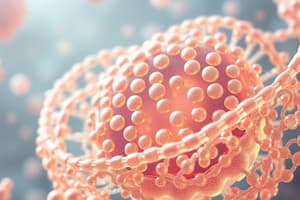Podcast
Questions and Answers
What is the main structural component of a phospholipid?
What is the main structural component of a phospholipid?
- Two fatty acid tails and a glycerol backbone (correct)
- Two phosphate groups and a glycerol backbone
- One fatty acid tail and a phosphate group
- Three fatty acid tails and a phosphate group
Which of the following correctly describes the amphipathic nature of phospholipids?
Which of the following correctly describes the amphipathic nature of phospholipids?
- Both regions are hydrophobic
- Lacks distinct structural regions
- Both regions are hydrophilic
- Has both hydrophobic and hydrophilic regions (correct)
In an aqueous environment, how do phospholipids arrange themselves?
In an aqueous environment, how do phospholipids arrange themselves?
- In clusters with heads facing inward
- In a monolayer with tails up
- In a bilayer with tails facing inward (correct)
- In a random configuration throughout solution
How do lipids contribute to energy storage?
How do lipids contribute to energy storage?
Which type of lipid is primarily responsible for energy storage?
Which type of lipid is primarily responsible for energy storage?
What distinguishes glycerophospholipids from sphingolipids?
What distinguishes glycerophospholipids from sphingolipids?
Which of the following lipids play a key role in cell recognition?
Which of the following lipids play a key role in cell recognition?
Which function is NOT associated with lipids in the body?
Which function is NOT associated with lipids in the body?
Flashcards are hidden until you start studying
Study Notes
Phospholipid Structure
- Basic Structure: Composed of two fatty acid tails and a phosphate group attached to a glycerol backbone.
- Amphipathic Nature: Has hydrophobic (fatty acid tails) and hydrophilic (phosphate group) regions, making them essential for forming cellular membranes.
- Forming Bilayers: In an aqueous environment, phospholipids arrange themselves into a bilayer, with hydrophobic tails facing inward and hydrophilic heads facing outward.
- Types of Phospholipids:
- Glycerophospholipids: Contain glycerol and are the most common (e.g., phosphatidylcholine).
- Sphingolipids: Contain sphingosine instead of glycerol (e.g., sphingomyelin).
Function Of Lipids In The Body
- Energy Storage: Lipids are dense sources of energy, providing 9 kcal/g.
- Cell Membrane Structure: Integral components of cell membranes, maintaining structural integrity and fluidity.
- Signaling Molecules: Serve as precursors for hormones and other signaling molecules (e.g., steroid hormones, eicosanoids).
- Insulation and Protection: Lipids insulate organs and body parts, helping with temperature regulation and cushioning vital organs.
- Nutrient Absorption: Aid in the absorption of fat-soluble vitamins (A, D, E, K).
Lipid Classification
-
Simple Lipids:
- Fatty Acids: Saturated (no double bonds) vs. Unsaturated (one or more double bonds).
- Triglycerides: Glycerol + three fatty acids; major form of stored energy.
-
Complex Lipids:
- Phospholipids: As described in the structure section.
- Glycolipids: Lipids with carbohydrate groups; involved in cell recognition.
-
Derived Lipids:
- Sterols: Steroid structures (e.g., cholesterol) contributing to membrane structure and precursor for steroid hormones.
- Waxes: Long-chain fatty acids with long-chain alcohols; provide protection and waterproofing.
-
Classification by Function:
- Energy Lipids: Triglycerides.
- Structural Lipids: Phospholipids and sterols in cell membranes.
- Signaling Lipids: Hormones and other bioactive lipids.
Phospholipid Structure
- Phospholipids are essential components of cell membranes, formed by two fatty acid tails and a phosphate group linked to a glycerol backbone.
- Their amphipathic nature, with hydrophobic tails and hydrophilic heads, allows them to form bilayers in aqueous environments.
- These bilayers serve as the structural basis for cell membranes, with hydrophobic tails facing inward and hydrophilic heads outward.
- Two main types: glycerophospholipids (containing glycerol, most common) and sphingolipids (containing sphingosine).
Function of Lipids in the Body
- Lipids are crucial for various bodily functions, primarily as efficient energy storage molecules (providing 9 kcal/g).
- They act as structural components of cell membranes, maintaining their integrity and fluidity.
- Lipids are also precursors for essential signaling molecules like steroid hormones and eicosanoids.
- They play a role in insulation and protection, shielding organs and regulating temperature through their hydrophobic nature.
- Lipids further contribute to nutrient absorption by facilitating the uptake of fat-soluble vitamins (A, D, E, K).
Lipid Classification
- Simple Lipids:
- Fatty Acids: These are the building blocks of many lipids, classified as saturated (no double bonds) or unsaturated (one or more double bonds).
- Triglycerides: These are the primary form of stored energy in the body, composed of glycerol bound to three fatty acids.
- Complex Lipids:
- Phospholipids: Are the main structural lipids of cell membranes, containing a phosphate group as described in the phospholipid structure section.
- Glycolipids: These lipids have carbohydrate groups attached, playing a critical role in cell recognition.
- Derived Lipids:
- Sterols: Structures like cholesterol are essential for membrane fluidity and act as precursors for steroid hormones.
- Waxes: These long-chain fatty acids with long-chain alcohols provide protection and waterproofing.
- Classification by Function:
- Energy Lipids: Triglycerides are the main energy reserves.
- Structural Lipids: Phospholipids and sterols are vital for cell membrane structure.
- Signaling Lipids: Hormones and other bioactive lipids play roles in cell communication and regulation.
Studying That Suits You
Use AI to generate personalized quizzes and flashcards to suit your learning preferences.



